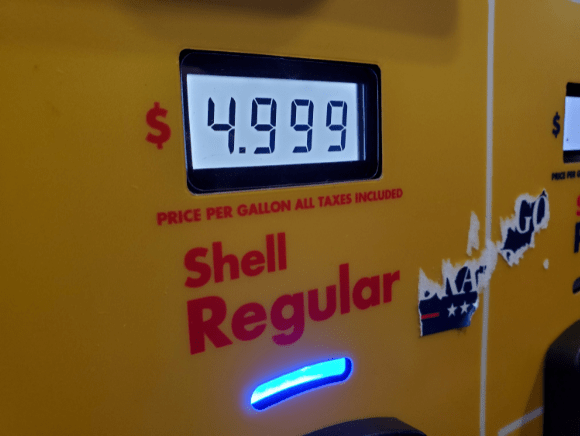Motorists are paying nearly a dollar more for a gallon of gasoline today than they did a year ago. The latest AAA data show that national average gas prices are $3.423 as of Feb. 4, up from $2.443 a year ago. This is the highest in more than seven years. Despite promises from the White House and assurances from some market analysts that gas prices would come down, consumers are still paying more at the pump without any respite in sight. But Americans are poised to spend a whole lot more on everything related to energy in the coming months.
West Texas Intermediate (WTI) crude oil prices ended the trading week around $92 per barrel. Brent crude, the international benchmark for oil prices, topped $93 a barrel. The front-month heating oil contract added more than 1% to $2.87 per gallon, while RBOB gasoline futures tacked on 1% to $2.67 a gallon. Well, at least natural gas eased with investors taking their profits.
 So, how high can oil and gas go in this economy? It is almost an inevitability that $100 crude and $4 gas are coming, driven by a blend of soaring demand, lackluster production, geopolitical tensions, rampant price inflation, and weather conditions. It turns out that adding 50 million barrels from the U.S. reserves did not do much in the grand scheme of things. Shock!
So, how high can oil and gas go in this economy? It is almost an inevitability that $100 crude and $4 gas are coming, driven by a blend of soaring demand, lackluster production, geopolitical tensions, rampant price inflation, and weather conditions. It turns out that adding 50 million barrels from the U.S. reserves did not do much in the grand scheme of things. Shock!
While Liberty Nation has discussed $100 over the last year, some industry experts are penciling in $200 crude over the next five years. Doug King, head of the Merchant Commodity Fund, told Bloomberg last month that there has been a paucity of exploration and capacity investment. “We believe in structural supply-side commodity inflation that most will not have ever seen – the highest since the 1970s,” adding that “a lot less oil is making its way to the market.”
Of course, green energy is a notable contributor to the renewed growth in fossil fuels. Since solar and wind power have been inadequate in the global reopening, countries have been turning over every rock to keep the lights on, leading to monumental growth in energy commodity prices, be it coal or crude. If you are an investor in Suncor, Exxon, or Cheniere Energy, you are raking in the black gold.
Americans Pick Team Red
Americans are ditching blue states and fleeing to red states, according to recent Census Bureau data that measures new U.S. state population and migration flow data for 2021.
Of the top ten inbound states, eight of them were Republican: Florida, Texas, Arizona, South Carolina, Tennessee, Georgia, Idaho, and Utah. North Carolina and Nevada also cracked the top ten. Of the top ten outbound states, eight of them were Democratic: Michigan, Minnesota, Hawaii, Louisiana, New Jersey, Illinois, New York, and California. Indeed, it is not surprising that Florida and Texas attracted hundreds of thousands of people, while California and New York witnessed an exodus.
The American Enterprise Institute (AEI) identified the disparity between the states people are migrating to and places where families are leaving. The top ten inbound states had smaller tax rates (individual and business), lower energy prices, modest home valuations, and higher annual employment growth. Interestingly enough, they were also Right-to-Work states.
In a separate study, WalletHub, a personal finance website, found that nine of the top ten states with the best employment recovery were Republican, although Virginia had recently turned red.
The $64,000 question is: Will these folks bring their left-leaning politics to these jurisdictions?
Hungry for Relief
Global food inflation is approaching a record high. The United Nations’ Food and Agriculture Organization (FAO) released the latest index of food prices, climbing 1.1% in January, buoyed by dairy, meat, and vegetables. The monthly food index is coming closer to the all-time high that took place in 2011.
Multiple factors are applying pressure to food prices: unfavorable weather conditions, the international energy crisis, the worldwide supply chain calamity, swelling fertilizer costs, and currency debasement. The only food item that eased in January was sugar, thanks to an enormous surplus. Everything else – from grains to vegetable oils – added to the month-over-month snapshot of food prices.
Although left-leaning economists assert that inflation does not impact the poor or middle-class, the UN’s FAO warned that the impecunious “will feel the pinch the most.” Moreover, farm adviser Agritel stated in a research note that these trends will decimate emerging countries, “which are lagging behind with deeper and lasting consequences of the crisis.”
Based on the performance of hard agricultural commodities, the FAO index could break the all-time high. Year-to-date, soybeans are up 16%, coffee has surged 8%, lean hogs have increased 6.1%, and corn has risen 4%. If consumers are fortunate enough to find full supermarket store shelves, they will be lucky enough to afford to pay for the groceries.
~ Read more from Andrew Moran.






